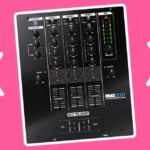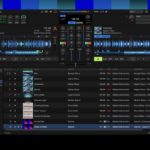Video Review
For DJs who are drawn down the less-is-more digital DJing route, small, single-jogwheel (or no jogwheel) external controllers can nowadays be used to control up to 4 virtual decks. We’ve recently rounded up most of those that are on the market, both with built-in sound cards and without built-in sound cards.
One of the interfaces we featured in our round-ups was the Reloop Contour, and we reserved definitive judgement on it until we’d had a chance to use one. Reloop has since supplied up with the Interface edition (£299/€319). Read on for the full review and a video overview.
So to recap what this thing is: It’s a DJ Midi controller with a built-in 8-out (4-stereo out) sound card. It is designed for you to control the 4 decks of Traktor Pro (or 2 decks of the supplied Traktor LE) right out of the box. You can plug it into 4 channels of a DJ mixer and use the mixer for audio mixing, EQ etc, or you can choose to use it without a mixer, feeding straight into a PA or one channel of a house mixer. Think Kontrol X1 with sound card built-in and a jogwheel. Or the Xone:2D with a bigger, touch-sensitive jogwheel.
First impressions/setting up
The first thing to say about it is that it’s big. It may only appear to be one “half” of a full-sized DJ Midi controller, but it’s deep and wide, with everything nicely spread out jumbo knobs and buttons, and no feeling of being cramped.
Partly because of this, and also because it is of all-metal construction, it feels 100% professional – no sense at all of this being a consumer or “toy” product. It is fair and square “serious”, and wouldn’t look out of place next to anything else in a high-end DJ set-up.
The jogwheel has no wobble or give at all in it, and the several types of knobs and faders feel pleasing, variously in rubber, metal and plastic. While the “click” when you press the buttons is maybe a little cheap feeling, it doesn’t detract overall from the quality feel of the unit.
The Contour is not deep, unlike the Allen & Heath Xone:2D, and because of this, it is still reasonably portable, although if space is seriously at a premium in any venues you’re considering using this in, you may struggle due to the larger than average footprint for this type of controller.
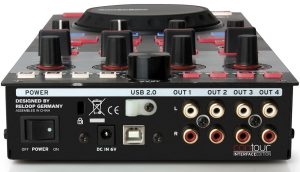
It has 1/8″ and 1/4″ headphone jacks on the front (a nice touch), and 4 x stereo RCA-outs, a USB socket, a heavy duty on/off switch and a power jack socket round the back.
The power supply is a rather cheap affair, and I’d rather have seen a more heavy duty unit, but having said that, the Contour worked fine from just USB power with my laptop, so I didn’t need the external power anyway. I guess as a backup, the external adaptor supplied is fine.
Setting it up for Mac or PC is a case of installing the required drivers so the correct audio settings appear within Traktor, and then configuring the audio depending upon whether you want to use it as part of a bigger set-up with separate external outs, or with its internal mixer feeding straight into a PA or one channel of an existing setup.
Either way, there are no surprises and set-up was quick and easy – although there are no Mac instructions in the supplied booklet, and the booklet on the CD is just a copy of the slim paper one that comes in the box. If you’ve never set up a DJ Midi controller before, you may wish there was a little more help.
The unit comes with Traktor LE, which is fine for getting going but has the usual LE restrictions as detailed in this article. If you want to DJ seriously with this, you’ll want the Pro version of Traktor, available at a discount to purchasers of the unit. This is the only way to unlock full effects functionality and 4-deck support.
In use
Using just one unit like this to control 4 decks of Traktor, plus to control all mixing functionality should you decide to use it without an external mixer, obviously involves some clever mapping of the controls and a few creative leaps of thinking to fit everything in.
As such, a lot of use is made of a shift button that doubles up most of the controls of the unit. This means that there is a slightly steeper learning curve for the DJ, but it’s inevitable – and luckily, Reloop has thought hard about how to make everything work well, particularly about how the Contour’s mapping uses the jogwheel to provide a number of common functions.
Overall, the way it has all been planned is intuitive and clever, and it’s one of the most impressive things about this controller. It’s fun to use and you’re flying around it on 4 decks really very quickly. In external mixing mode, you plug 4 leads out of the back into 4 spare channels of a mixer and use your crossfader, gain, volume EQ etc externally. Thus all this unit has to do is provide control over the individual decks.

You select the decks using 4 buttons top right. When you press one of the deck buttons, all the setting for that deck light up on the unit – the buttons are backlit so you can see where the loop, transport and FX settings were left, for instance – and you can go ahead and make your changes.
The jogwheel can have its use altered by pressing one of 4 big buttons immediately above it. It can be used for scratching or pitch bending depending upon whether you’ve enabled the scratch mode and where you touch it – like Vestax controllers, the metal faceplate of the jogwheel is touch-sensitive and allows you to scratch, while the plastic edge allows you to pitch bend.
Because of this, the scratch/pitch bend buttons are kind of redundant – however, I suppose it is good to be able to turn scratching off completely to save clumsy fingers accidentally scratching when you wanted to pitch bend.
The search button turns the jogwheel into a good scrub control to quickly fly through a track and can work even quicker when used with the shift button. Finally, the trax button full-screens the library and allows you to use the jogwheel to scroll through your music quickly – again, double fast when pressed with the shift button.
The latter would probably be good for set planning, but for just picking the next song, you’d probably use the trax knob at the top centre of the controller the most. It lets you scroll through your tunes within the usual Traktor window, and pressing it downloads the chosen song on to the deck that’s active. It’s fast and simple.
The top 4 knobs are dedicated to Traktor’s FX, allowing selection of effects as well as dry/wet control and parameter control using the shift functionality. The 4 faders allow for very fast FX manipulation. Combined with the 4 buttons immediately underneath, this section allows you complete control over all Traktor FX settings – and while FX use is limited in the LE version of the software, once you have Pro you can do a hell of a lot here.
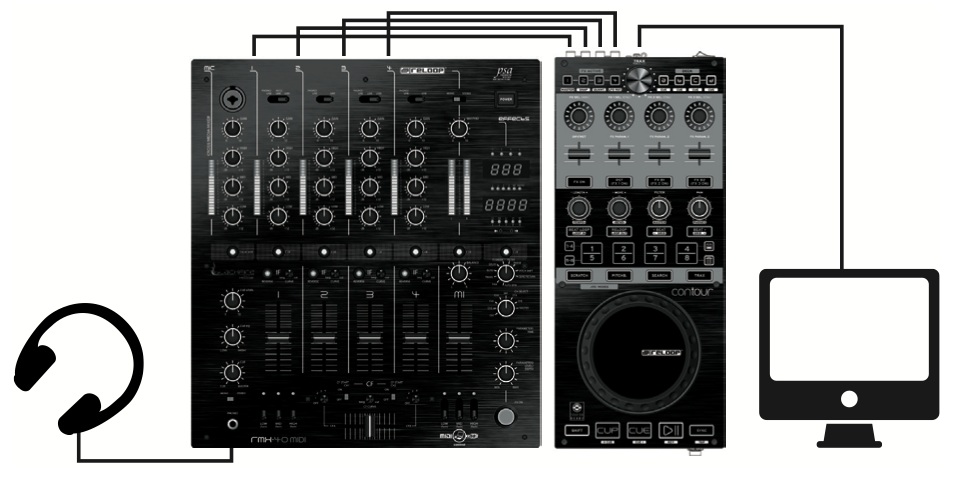
The 4 knobs underneath control loop length, loop position, loop in/out, filter and beatgridding, and are clever though out with continuous click or centre click depending on their function. The area underneath lets you set, toggle, save and discard all 8 cue points for each channel.
The transport controls are as you’d expect, with both CUE and CUP available, and a sync button alongside the play/pause – again, shift functionality is available for further cue options, and also for keylock toggling and BPM tap.
Using it in standalone mode
So that’s the main control layout – but what if you want to also use the Contour as your mixer? Here’s where some clever mapping in addition to the above makes it all pretty easy.
For instance, shift and the left-hand fader control headphones volume, shift and the next three fader controls low/mid/high for the selected channel, shift and pressing the three knobs above the faders gives you low/mid/high kills, and the right-hand knob of the middle four controls pan and master volume depending on whether shift is pressed or not. To control individual track volume, you ensure that none of the jogwheel function buttons are lit, and use the jogwheel as giant rotary volume.
The edge of the jogwheel controls the selected channel’s volume finely, the touch-sensitive part rapidly, allowing reasonable cutting in of the volume with a bit of practice. You’re certainly not going to large it DMC-style in this mode (no crossfader, for instance), but for smooth house mixes it’s going to be fine.
Of course as with any Midi controller, once you get used to it, you’re probably going to change the supplied mapping to suit you.
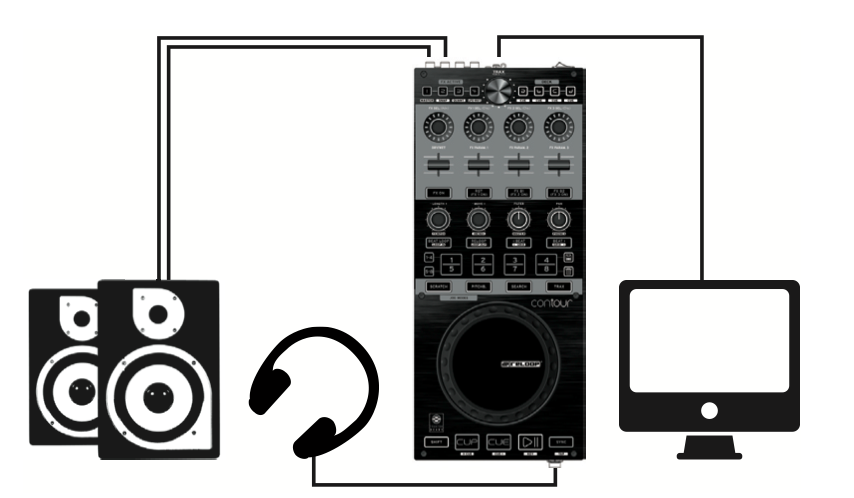
For instance, if you’re using it in internal (standalone) mode, you may remap it so you don’t need to hold shift down for some of the mixer controls, and personally, I’d map the Pan knob out immediately as everywhere I play has a mono PA anyway. But the truth is that the unit comes with a pretty clever one-size-fits-all mapping that you shouldn’t have to change too much to make it right for you. But having spent a few hours playing with this on Traktor Pro, I felt comfortable and more importantly, found it a fun controller to use.
Conclusion
Its main competition is the pricier Xone:2D, which is slightly less portable due to its weight and shape. Also the Xone:2D doesn’t provide the clever jogwheel functionality of this controller, which overall is more modern in its integration with Traktor, as befitting a newer product.
The 2D is higher end though, and that’s what you’re paying the extra for with the Allen & Heath unit. Expect to spend more time mapping it to do what you want, though.
Your choice may well come down to availability – we couldn’t find any US retailers at the time of going to press who were sticking this unit, but we expect it to become available worldwide shortly. If you’re in the market for a well-built, compact, highly configurable and flexible 4-deck Midi controller for Traktor, complete with a built-in 8-out sound card, you should certainly have the Reloop Contour Interface Edition on your short list.






